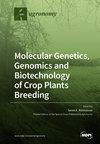Distinguishing Cyst Nematode Species Using Image Textures and Artificial Neural Networks
IF 3.3
2区 农林科学
Q1 AGRONOMY
引用次数: 0
Abstract
Cyst nematodes are plant parasitic nematodes infecting crops, causing extensive crop damage and annual losses, and affecting food production. The precise species identification is significant to initiate their control. The repeatable, less expensive, and less laborious distinguishing cyst nematode species using image processing and artificial intelligence can be advantageous. The objective of this study was to distinguish cyst nematodes belonging to the species Globodera pallida, Globodera rostochiensis, and Heterodera schachtii based on image parameters using artificial neural networks (ANN). The application of parameters selected from a set of 2172 textures of images in color channels L, a, b, X, Y, Z, R, G, B, V, U, and S to build classification models using a narrow neural network, medium neural network, wide neural network, trilayered neural network, WiSARD, multilayer perceptron, and RBF network is a great novelty of the present study. Algorithms allowed for distinguishing cyst nematode species with an average accuracy reaching 89.67% for a model developed using WiSARD. The highest correctness was obtained for H. schachtii and this species was distinguished from each other with the highest accuracy of 95–98% depending on the classifier. Whereas the highest number of misclassified cases occurred between G. pallida, G. rostochiensis belonging to the same genus Globodera. The developed procedure involving image parameters and artificial neural networks can be useful for non-destructive and objective distinguishing cyst nematode species.利用图像纹理和人工神经网络识别囊性线虫种类
囊线虫是一种植物寄生线虫,感染作物,造成广泛的作物损失和年度损失,并影响粮食生产。准确的物种鉴定对启动它们的控制具有重要意义。使用图像处理和人工智能可重复、成本较低且不费力地区分囊线虫物种可能是有利的。本研究的目的是使用人工神经网络(ANN)基于图像参数来区分属于苍白球藻、罗斯托奇氏球藻和沙赫氏异足线虫的囊线虫。应用从颜色通道L、a、b、X、Y、Z、R、G、b、V、U和S中的2172个图像纹理中选择的参数,使用窄神经网络、中等神经网络、宽神经网络、三层神经网络、WiSARD、多层感知器和RBF网络建立分类模型,是本研究的一大创新。算法允许区分囊肿线虫物种,使用WiSARD开发的模型的平均准确率达到89.67%。沙奇H.schachtii获得了最高的正确性,根据分类器的不同,该物种以95-98%的最高准确率相互区分。而错误分类病例最多的发生在苍白球藻和属于Globodera属的罗斯托奇球藻之间。所开发的涉及图像参数和人工神经网络的程序可用于无损和客观地区分囊线虫物种。
本文章由计算机程序翻译,如有差异,请以英文原文为准。
求助全文
约1分钟内获得全文
求助全文
来源期刊

Agronomy-Basel
Agricultural and Biological Sciences-Agronomy and Crop Science
CiteScore
6.20
自引率
13.50%
发文量
2665
审稿时长
20.32 days
期刊介绍:
Agronomy (ISSN 2073-4395) is an international and cross-disciplinary scholarly journal on agronomy and agroecology. It publishes reviews, regular research papers, communications and short notes, and there is no restriction on the length of the papers. Our aim is to encourage scientists to publish their experimental and theoretical research in as much detail as possible. Full experimental and/or methodical details must be provided for research articles.
 求助内容:
求助内容: 应助结果提醒方式:
应助结果提醒方式:


